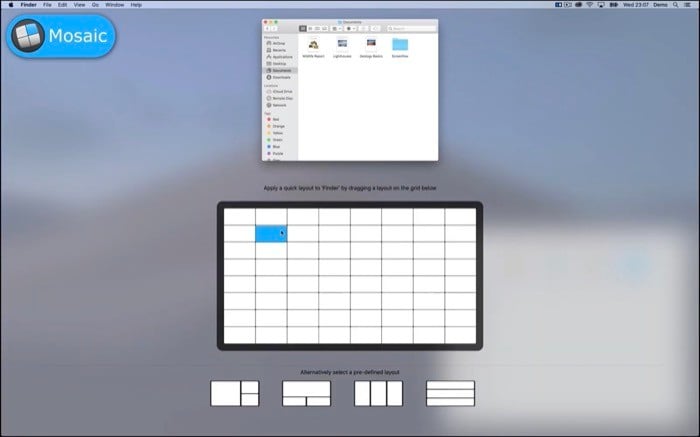What you can get, though, are some good third-party window management apps that let you manage your desktops. However, you should know that, besides helping you in resizing and organizing windows on your desktop, these apps cannot be used to replace or extend the functionalities of macOS’ default display server, Quartz, which is what you would need to do to extend the tiling functionality on Mac. Quartz Compositor is essentially an internal system component on Apple’s macOS-powered computers. It is responsible for presenting the rasterized graphics from the various graphics rendering frameworks. And, it also plays its role as a compositing window manager to offer screen buffer to all the different apps on your desktop.
Best Window Manager Apps for macOS
If you are a macOS user and multitask with multiple apps at once, you would be aware of the built-in window manager functionality, Split View, that lets you run two apps simultaneously in a split window setting. To add to that, if you use it to manage your desktop, you would also be familiar with its shortcomings and the limited scope of use. And therefore, it is likely that you might be on the look for some better window managers for your Mac.
So, to help simplify the process for you, here is a curated list of some of the best window management software for macOS. Most of these apps are very similar in terms of fundamental functionality — how they solve the window management problem. But, the approach involved and the functionality offered by each of them is what sets them apart.
1. Rectangle
Rectangle is my preferred tool of choice for managing windows on Mac. It is free and open-source and the best solution out there for anyone just getting started with a window manager for the first time. Being open-source, Rectangle offers some conventional open-source advantages over its closed-source counterparts. One, it is available to use for free. And second, it allows anyone with the knowledge of coding to come up with bug fixes and feature add-ons.
The set of functionalities offered on Rectangle are more than sufficient for most people. And the ease of use further adds to the experience. Arranging windows can be done either by clicking on the desired window setting from the menu bar or by using custom keyboard shortcuts. The latter requires you to memorize the shortcuts for different window setting layouts, but once you get acquainted, you can get quick and efficient at organizing your desktop. If you already use a lot of shortcuts on your Mac and want to change the default ones on Rectangle, you can do so from the preferences. Free Get Rectangle
2. Magnet
Magnet is another popular Mac window manager app and an alternative to Rectangle. In some sense, this and Rectangle both share some similarities. However, the same ends with the pricing aspect. Unlike Rectangle, which is open-source and available for free, Magnet is a paid app downloadable from the Mac App Store.
Talking about functionality, organizing and arranging windows is as simple as snapping application windows onto different positions on the screen. You can either use your mouse to drag and drop a window to your desired position or leverage the keyboard shortcuts to move windows. These are customizable keyboard shortcuts, and you can change them to suit your preference. Similar to Rectangle, Magnet also has a menu bar icon, which presents you with different window layouts to choose from for your desktop. Lastly, if you use multiple screens, you get support for up to six external monitors with different orientations. Paid: $4.99 (Rs 449) Get Magnet
3. BetterSnapTool
If this isn’t obvious by the name, BetterSnapTool is a simple window positioning and resizing utility for Macs that aims to solve the window management problem. The app allows you to change the window positions and sizes in its preset layouts. In addition, you also get to arrange your desktop in your preferred custom layout. One of its best features is that it gives you the ability to set application-specific snapping sizes for different apps. This can come in handy when you need more than two app windows open on your desktop and want certain apps to occupy only a specific part of your screen estate.
You can drag-and-drop windows to specific portions of the screen to snap them. Alternatively, you can use keyboard shortcuts to perform the same actions efficiently. Talking of which, BetterSnapTool offers a pretty wide range of customization options that let you change a lot of the aspects of the resizing and snapping functionality. Similarly, you also get to select behavior for what happens when your double-click a window’s title bar. Finally, in terms of a multi-monitor setup, BetterSnapTool offers support for multiple screens. So if you have such a setup, you can use the software to manage windows across all your monitors. Custom window sizes and positioning are some of its unique features. Paid: $2.99 (Rs 269) Get BetterSnapTool
4. Mosaic
Mosaic is a much powerful window manager for macOS than all the apps we have listed so far. It is a highly customizable software that you can use to organize your desktop in your preferred layout and categorize the open windows in a way that makes them more accessible. In addition, Mosaic offers both drag-and-drop and keyboard shortcut functionality to resize and reposition windows on your desktop. Moreover, if you own a MacBook with TouchBar, you get access to all the layouts at your fingerprints.
Aside from the standard features, Mosaic, being a powerful window manager, offers a slew of other functionalities and customization options. For example, you can create custom layouts, set a quick single-use layout, adjust the padding (space around windows), and apply auto-layout to a window to make it remember where you want it on your desktop. In addition, you also get to create layout groups to make switching between different sets of windows convenient and remotely control your desktop windows using your iPhone or iPad. 7-day free trial, Paid: £9.99 Get Mosaic
5. Divvy – Window Manager
Divvy is yet another powerful window manager for the macOS operating system. The software is pretty user-friendly and does not require you to learn a lot of keyboard shortcuts to be able to use it to its full potential. One of the best bits about Divvy is that you get a quick layout setup interface on the screen that lets you easily manage the placements of windows on your desktop without requiring you to manually drag-and-drop them.
Divvy’s quick setup interface not only saves time but also provides a convenient approach to those new to window management. As for advanced users, there is still the option to use keyboard shortcuts for quick window snapping. Plus, needless to say, the software allows for customizing the keyboard shortcuts, changing preferences for various appearance settings, and setting up individual shortcuts for different window resizing needs. Last but certainly not least is support for a multi-monitor setup, which lets you organize and arrange windows on desktops across all your external displays to increase your productivity. 7-day free trial, Paid: $13.99 (Rs 1249) Get Divvy
6. Moom
Moom (move and zoom windows) is the most straightforward window management utility on the list. You can use it to effortlessly move and zoom windows on your desktop to different regions. For example, suppose you’ve used macOS’ Split View. In that case, you will find Moom’s functionality aligning with it to a certain extent — especially the different layout options, which are accessible from the arrow button in the window title bar on both utilities. When you click on the green button, Moom presents you with a pop-up palette. This palette offers a bunch of different preset layouts, which you can click on to arrange windows on your desktop.
While the pre-configured layouts work perfectly fine, if you want to resize and arrange windows in a custom layout, you can click on the empty box in the Moom palette and click-and-drag the mouse to draw out the dimensions for your window. Besides, Moom also offers the Snap to Edges and Corners feature, which lets you grab a window and drag it to an edge or corner to snap it in place. If you prefer using a keyboard over a mouse, the software gives you the ability to organize and arrange windows on your desktop using keyboard shortcuts. And, in addition to that, it also enables you to create custom commands to perform various window actions efficiently. The window layout can be saved as a Snapshot. The windows can then be easily restored to their original positions by activating that layout again later. 7-day free trial, Paid: $10 (Rs 899) Get Moom
Choosing the right macOS Window Manager for your needs
Those are some of the best macOS window management apps you can use on your Mac computers to manage multiple windows more effectively and efficiently. But before you proceed with these window managers, remember that these are basically applications that offer you better window management functionality. In no way do they extend the functionality of the system’s Quartz Compositor component. So, if what you want is a solution that (kind of) replaces Quartz and offers you slightly more freedom over managing windows on your Mac — kind of like Linux — Amethyst and chunkwm (now Yabai) are two popular options you should check out. Having said that, if you only need a way to manage windows on your Mac desktop properly, you can put to use our listed apps/software to get a whole lot more done and have a tidy and organized desktop that provides a streamlined working environment.
1. What is the window manager for Mac?
“Mac window manager” is a term for a group of applications that let you organize and resize windows using built-in keyboard shortcuts, mouse clicks, and gestures. We will show you some of the best window manager apps for Mac that can help you organize your desktop.
2. How do I manage multiple windows on a Mac?
Split View is the built-in functionality on macOS to manage multiple windows. Click and hold the “Full Screen” button in the upper left corner of a window. If you hold the button down, the window will shrink and you can drag it to the left or right edge of the screen. Release the button and then click a window on the other side of the screen to use both windows side by side. But it’s still pretty limited in terms of flexibility, and we suggest you use one of the above mac window manager apps we have mentioned above.
3. Can you tile more than 2 windows on Mac?
While macOS supports multi-window support via Split View, Apple is restricting Split View for just two apps at a time. So tiling more than two windows isn’t really possible without using one of the above third-party tools.











